![]()
[Support] [Product Info] [Downloads] [Ordering] [Home <www.channld.com/software.html>]
Audio Delay Finder Beta (ADFB)
What does Audio Delay Finder do?
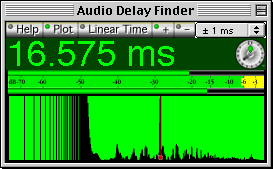
|
Audio delay finder performs a single task - it measures the signal delay between two audio input channels. For example, comparing the signal delay between music fed to a loudspeaker system and the signal from a microphone, placed some distance away from the loudspeaker. This information is useful for time-alignment of auxiliary loudspeaker systems, so that sound arrival times from the primary and auxiliary systems can be made coincident, as is done in sound reinforcement applications. In the absence of signal coloration and strong reflections from surfaces, ADFB will display a principal peak corresponding to the sound propagation delay between loudspeaker and microphone. (Nonlinear phase response, reflections from surfaces, etc. will contribute other peaks). For example, with a microphone placed 20 feet from a loudspeaker, the signal driving the loudspeaker fed to Macintosh sound input channel 1 and the signal from the microphone directed to channel 2, ADFB would show a principal peak at 18.18 milliseconds (presuming nominal sound propagation velocity of 1100 feet / second; affected by atmospheric pressure, humidity, etc.) Also note that the ADFB response plot represents the impulse response of the system under test. |
System Requirements: Any Power Macintosh. Needs 7 MB free RAM for launch.
Application Size: Optimized PowerPC native code, less than 100 k.
Downloading:
Please read the User Licensing Agreement for Audio Delay Finder Beta before downloading.
Download Audio Delay Finder Beta (90 kB, .hqx encoded, self-extracting file)
We kindly welcome any feedback (softsupportadf![]() ) about Audio Delay
Finder Beta.
) about Audio Delay
Finder Beta.
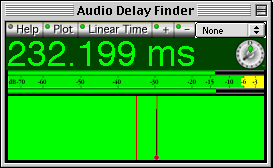
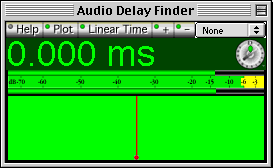
Example above: First measurement: audio signal directed to input channel 2 was delayed by approximately 232 milliseconds. (To create the delay for the channel 2 signal, the signal directed to channel 1 also was fed through an audio digital delay processor unit, and then directed to channel 2). Second measurement: identical signal directed to both input channels. Linear time scale; positive and negative delays plotted. Note: signals of smaller input amplitude may display an envelope response about the primary peak(s).
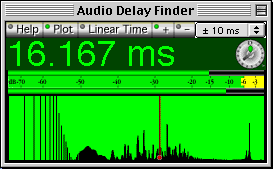
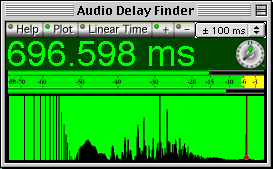
Example above: Richard Lloyd, "Real Time" (SLAMM Records' "SLAMCD 32," playback from audio CD). The measurement determined that a primary stereo effects delay of 16 milliseconds was used in the recording, plus secondary stereo delay of about 700 milliseconds. For the second measurement, Audio Delay Finder was set to ignore delays less than 100 milliseconds. Logarithmic time scale; positive delays only.
[Support] [Product Info] [Downloads] [Ordering] [Home <www.channld.com/software.html>]